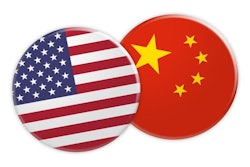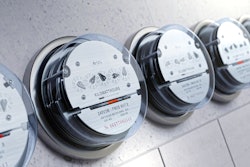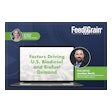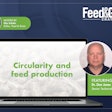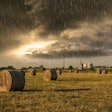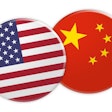Elise Schafer, editor of Feed & Grain: Hi, everyone, and welcome toFeed & Grain Chat。I'm your host Elise Schafer, editor ofFeed & Grain。This edition of Feed & Grain Chat is brought to you byWATT Global MediaandFeedandgrain.com。Feedandgrain.com是酸的ce for the latest news,product and equipmentinformation for the grain handling and feed manufacturing industries.
Today I'm joined on Zoom by Corey Rosenbusch, president and CEO ofThe Fertilizer Institute。He's here today to talk about some of the biggest challenges and opportunities facing the fertilizer industry. Hi Corey, welcome to Feed & Grain Chat.
Corey Rosenbusch, president & CEO of The Fertilizer Institute: Hey, thank you. Glad to be on with you, Elise.
Schafer:Well, I’m happy to have you on with us today! Now, can you tell us what role fertilizers play in supporting global food security, and what challenges does it face in meeting increased demand for food?
Rosenbusch: It was really fascinating to watch shortly after the war in Ukraine broke out with Russia, to see the fertilizer industry appear on the evening news — it was showing up everywhere. I think the the entire population around the globe was quite concerned about Ukrainian wheat and all of the Russian fertilizer products and how was Africa going to feed the continent, so it really took center stage as a result of that conflict.
I think it raised awareness to a lot of the general public the important role that fertilizer plays in feeding the world. About half of the world's crop yields can be attributed to fertilizer. So, in one way you can think about it half of us wouldn't be on this planet if it weren't for fertilizers to generate the yields that we need to feed the population.
Schafer:Now what about the challenge around U.S. infrastructure and its transportation network. How does that impact farmers’ access to fertilizer?
Rosenbusch:大量的肥料,是一种商品,moves by really all modes of transportation. Rail is a significant player with about 60% of all of the fertilizer ton miles moved by rail shipments, and every single ton of fertilizer will touch a truck at some point.
On the rail side services has been a real challenge for the industry. Whether it's demerged issues or being able to get access to the service that they need to load and make shipments, we've had a lot of focus with the Surface Transportation Board on really trying to improve all the class one railroads service to the industry.
We had a lot of curtailments that some of the rail shippers had announced at that time and, and even took a couple of cases to the surface transportation board to ensure that that didn't happen in the time sensitivity around spring planting season even makes the supply chain even more challenging.
From a waterway standpoint, about a third of the fertilizer will utilize our inland waterway system. Those barges will bring grain out from the heartland and then take fertilizer back in. We rely heavily on the locks and dams. Weather will play play a huge role, whether it's flooding, or as we saw last year, we had some real issues withnot enough water in the waterway systemto get barge traffic up and down.
Really every mode of transportation is critical. We really applaud the investments the federal government have made in the Infrastructure and Jobs Act that will dedicate some resources toward improving that infrastructure.
I'd say a real focus has been on therail side to see what we can do to help and improve service。All of that is as at a time, back to your previous question about what some of the biggest challenges are, when we have a really complex market situation. I'd say that's been issue number one. I think any farmer will tell you the price of fertilizer over the last 20 months has been quite volatile. We saw some some products increased by as much as 300% year and a half ago. Those markets have softened. I know farmers who are really happy about that going into spring planting, but, at the same time some of that inventory was still leftover from the fall.
I think the critical issue that we think about when we look at markets is that it's a globally traded commodity, just like grain and other other crops are.
What China does with their fertilizer, which is the largest producer of fertilizer in the world, will impact the farmer here. They actually restricted exports. They're one of the largest suppliers to India, which is one of the largest users of fertilizer, and when you remove that kind of tonnage, from the global marketplace, it has a huge impact.
Or look at Russia, whose the second largest producer of fertilizer. Almost 50% of the world's potash is in Russia and Belarus, so sanctions that were placed on both of those countries made a huge impact on global supply. All of those trade patterns then begin to shift when you have certain countries not buying the product -- meaning they have to shift to other other regions that will be able to buy that product. All of that will impact the price a farmer will have to pay right back here in the United States. That's probably been one of the most significant challenges that we've been working through, really over over the last two years.
Schafer:Yeah, it's certainly a big one. Now, the fertilizer Institute named the environment as one of its top policy priorities for 2023. In what ways can fertilizers support sustainable agriculture practices?
Rosenbusch:这很有趣,因为我正在跟一些students the other day, and they were trying to figure out what is it the Fertilizer Institute does. Probably the simplest way to explain it is we protect the industries licensed to operate. As we think about that license to operate, or in another way, to think about how a farmer can guarantee they have the nutrients to grow the crops they need. We're here to make sure that product can can enter the marketplace.
I would say the biggest threat and opportunity that we face as an industry is matters around the environment and sustainability. There are a number of initiatives that the industry has taken on to really demonstrate its stewardship of the environment and to make sure that license to operate and sell product continues to exist.
The first really centers around our 4R programs. The 4R's of nutrient stewardship management, which is ensuring that fertilizer is used at the right source rate and time and place is really driven by a framework that we promote heavily with our ag retail members. We even select advocates every year for our farmers that are using these practices in showing that nutrient use of efficiency is a key priority for the industry.
A lot of times people will talk about reducing fertilizer use. And it's not necessarily that we want to talk about the quantity, but we want to talk about the efficiency. No one wants to waste money, farmers don't want to see nitrogen loss to the environment, whether that's our waterways or volatize into the air. They're very committed to these programs, and it's an opportunity for us to promote them.
We even have some research we're doing to quantify and measure the environmental impact of these practices, so we can show reduction in greenhouse gas emissions. As a result of using those good-for-our-nutrient stewardship practices, we also see a lot of innovation in the space. We have a tremendous opportunity to introduce new products and tools that growers can use, whether those are innovative products such as coatings, or slowly released products or nitrification inhibitors or biostimulants. Those are all tools that a farmer can complement traditional NPN K application to make sure that fertilizer is used most efficiently.
Probably one of the hottest topics right now is low carbon ammonia manufacturing. A number of the nitrogen manufacturers, as well as outside players, have announced projects to more sustainably produced nitrogen. The Haber-Bosch process of taking the nitrogen from the air and chemically reacting it with natural gas produces significant amount of CO2。
The latest Inflation Reduction Act (IRA) has created some tax incentives that will allow nitrogen producers to invest in carbon capture as well as low carbon ammonia production through the use of green technology, which in some ways opens up an entirely new marketplace because ammonia could be a significant energy source for the future, carrying that hydrogen model molecule that could be used as a hydrogen fuel source, or as a low carbon nitrogen option for growers as well. So there are tremendous opportunities, even though it is one of our biggest challenges, and we're excited to always promote and share those stories.
Schafer:Well, Corey, thank you so much for your insights today.
Rosenbusch:It's been my pleasure. Thanks for having me.
Schafer:Well, we’re glad you could join us. That's all for today'sFeed & Grain Chat。If you'd like to see more videos like this, subscribe to ourYouTubechannel, sign up for theIndustry Watch daily eNewsletter, or go to feedandgrain.com and search ourvideos。Thank you for watching, and we hope to see you next time!







